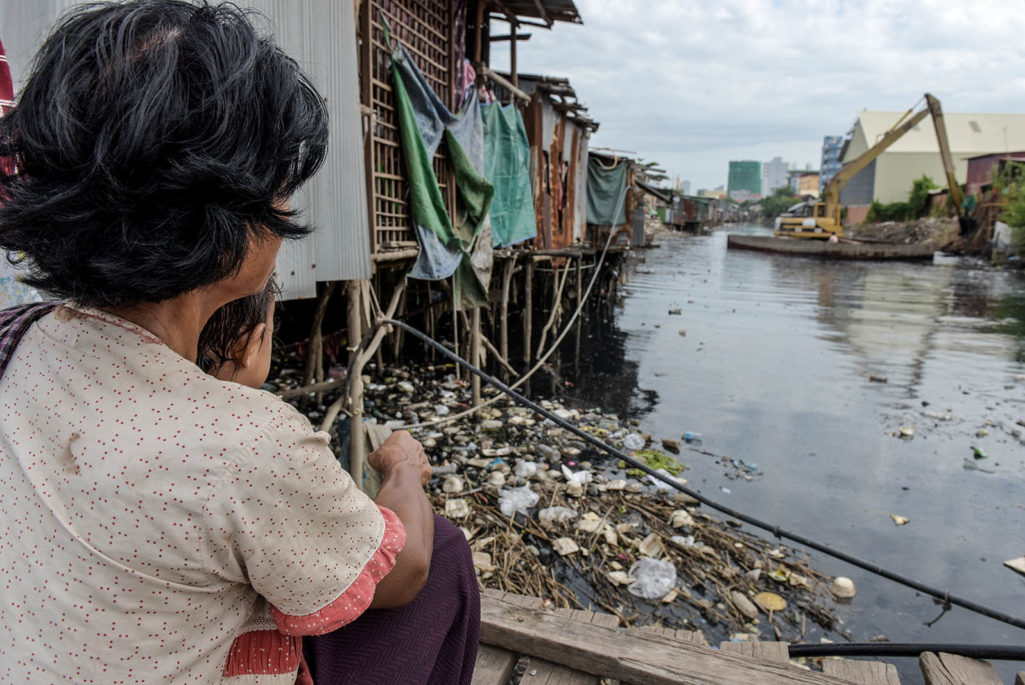Securing Asia’s Urban Water

A Cambodian woman looks at an excavator (back R) dredging waste from a canal in a village slum in Phnom Penh.
Photo: Tang Chhin Sothy/AFP/Getty Images
Although population growth and development pressures both influence water cycles, climate change is the main factor affecting the global hydrological balance, largely in an irreversible way. Examples are the accelerated depletion of the world’s largest aquifers, as well as the unsustainable rate at which glaciers are melting.
The impact of climate change on water has serious implications for cities, confronted with a likely future of greater climatic seasonal variability, curtailed freshwater stocks and increasing consumption. Cities must act and adapt to these threats through better planning, design and management.
Water supply, drainage and flood management, sewerage networks and other water-related infrastructure are often a top priority in the development plans and budgets of cities. Yet, uncoordinated and competing government agencies, financial constraints and rapid sprawl often lead to unsynchronized, inefficient and disintegrated water solutions. Moreover, while densification can deliver better services and infrastructure through economies of scale, it has not always resulted in more sustainable and water-sensitive cities in Asia. Loss of open spaces and draining of water bodies may reduce available water sources and increase flood risks, as well as hamper disaster preparedness, ecosystem regeneration, and coping mechanisms for extreme temperatures.
A Slow Embrace of Sustainability
Asian cities are slowly embracing new approaches to water planning—in some cases with ADB as partner. For example, confronted with repeated signs of water stress, the Indian state of Karnataka is testing an urban catchment model in small and medium cities that integrates planning and cascading of water resources and flows, and has launched a program to rehabilitate small lakes. In Thailand, Bangkok’s storm management strategy proactively integrates the combined collection and treatment with lakes and storage basins.
Steps toward the adoption of circular economies are also emerging. In Mangalore, Karnataka, effluent from sewage treatment plants is reused for industrial purposes in the city’s special economic zone. Meanwhile Mandalay, Myanmar is constructing its first wastewater treatment plant powered by biogas and where sludge will be reused for agriculture and cement works.
Beyond planning, design and construction choices can also positively impact urban water security strategies.
Beyond planning, design and construction choices can also positively impact urban water security strategies. In cities with densely packed roads and buildings, surfaces are mostly sealed, preventing rainwater seepage into the ground. This is at best a waste of water resources, and at worst the cause of floods. Green infrastructure (such as green roofs, rain gardens or bioswales), permeable pavements and subsurface detention systems—which facilitate the natural movement of water, and help collect and manage stormwater runoff and infiltration into the ground—are now core elements in city development around the world, from New York to the People’s Republic of China and its ‘Sponge Cities’ program.
Some advanced knowledge-based tools can also help manage urban water cycle risks, and need to be part of any city’s modernization process. Sensors, data management systems and models—such as those currently being designed for Hoi An, a city in Vietnam, and Kolkata’s flood forecast and early warning system pilots—support decision-making, particularly in extreme conditions.
Another issue is reducing waste. In cities like Manila, Philippines and Phnom Penh in Cambodia, public utilities have made extraordinary water conservation efforts so that “no drop of water goes unused.” Leakage reduction programs have brought water losses to levels well below those experienced in many countries in Europe or North America. However, these programs remain an exception; focused on repairs, they require constant dedication, offer few opportunities for ribbon cutting, and while less costly than new infrastructure investments, still require substantial expenditure on asset rehabilitation.
Systematically installing meters and applying volumetric tariffs can help manage demand, but this is not always enough. Policies and (green building) construction codes may need to promote and incentivize using low-consumption fittings and controls, and where potable water is not needed, options such as rainwater harvesting and gray water recycling should be pursued.
The recent UN Climate Change Conference in Marrakech called for more attention to be given to looming threats of water scarcity and security. Although urbanization is the defining trend in Asia’s transformation, its speed is outpacing planning and development, and compromising the quality and availability of water-related infrastructure and services. To address these concerns, we need a shift in approach and rapid replication of best practices through good leadership, policymaking and financing.
The piece first appeared on the Asian Development Blog.




